Published photos of the newest Russian robots "Lynx-BP" and "Avatar"
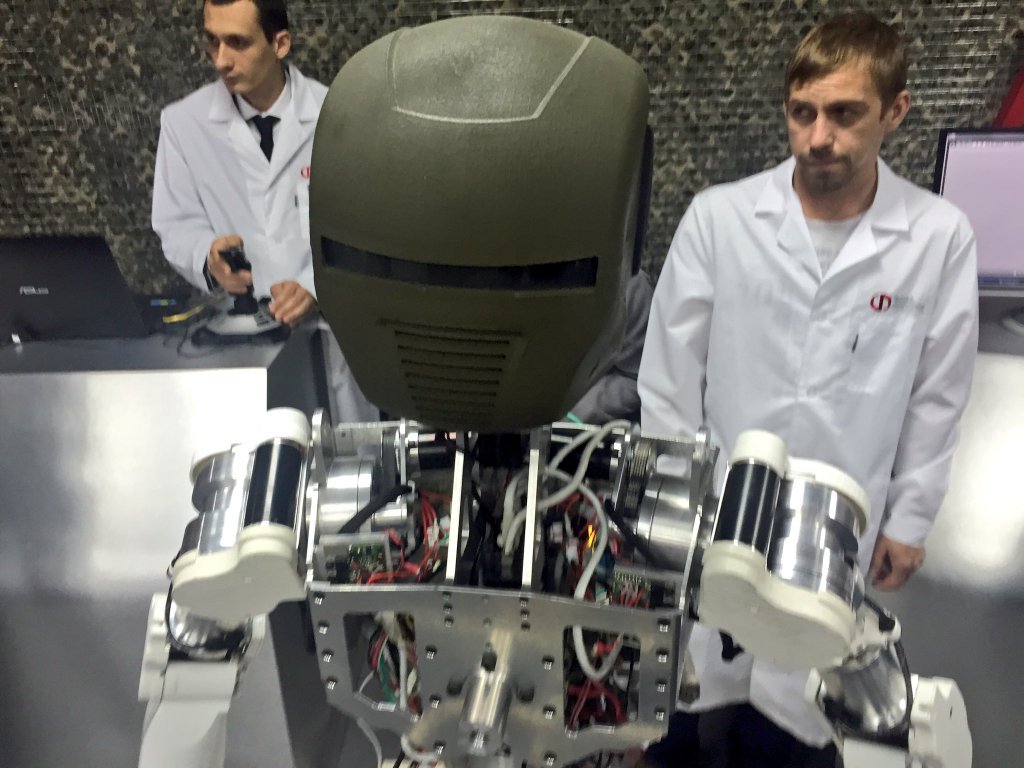
Robot "Avatar". Photo: twitter.com/i_korotchenko
The exhibition of the experimental laboratory of TsNIITOCHMASH OJSC presents the latest developments of Rostec research institutes - the prototypes of the Rys-BP and Avatar robots, as well as the army exoskeleton. These developments were briefly reported earlier, but they were shown to the public only now.
"Lynx-BP" and "Avatar" can be used for rescue, in astronautics ("Avatar"), as well as fighting robots with the appropriate weapons.
"Avatar"
The anthropomorphic robot "Avatar" is being created in the NGO "Android Technique" and the FSUE "TsNIImash" with the support of the Advanced Research Foundation. This robot will overcome the obstacle course and drive vehicles, as American robots did at the DARPA competition .
')
“The work program for this project provides for testing the robot at the obstacle course at the end of the year. Avatar has to overcome its elements, demonstrate the ability to control various technical devices, including a car, to climb the stairs, ” said Vitaly Davydov, Deputy General Director of the Foundation.

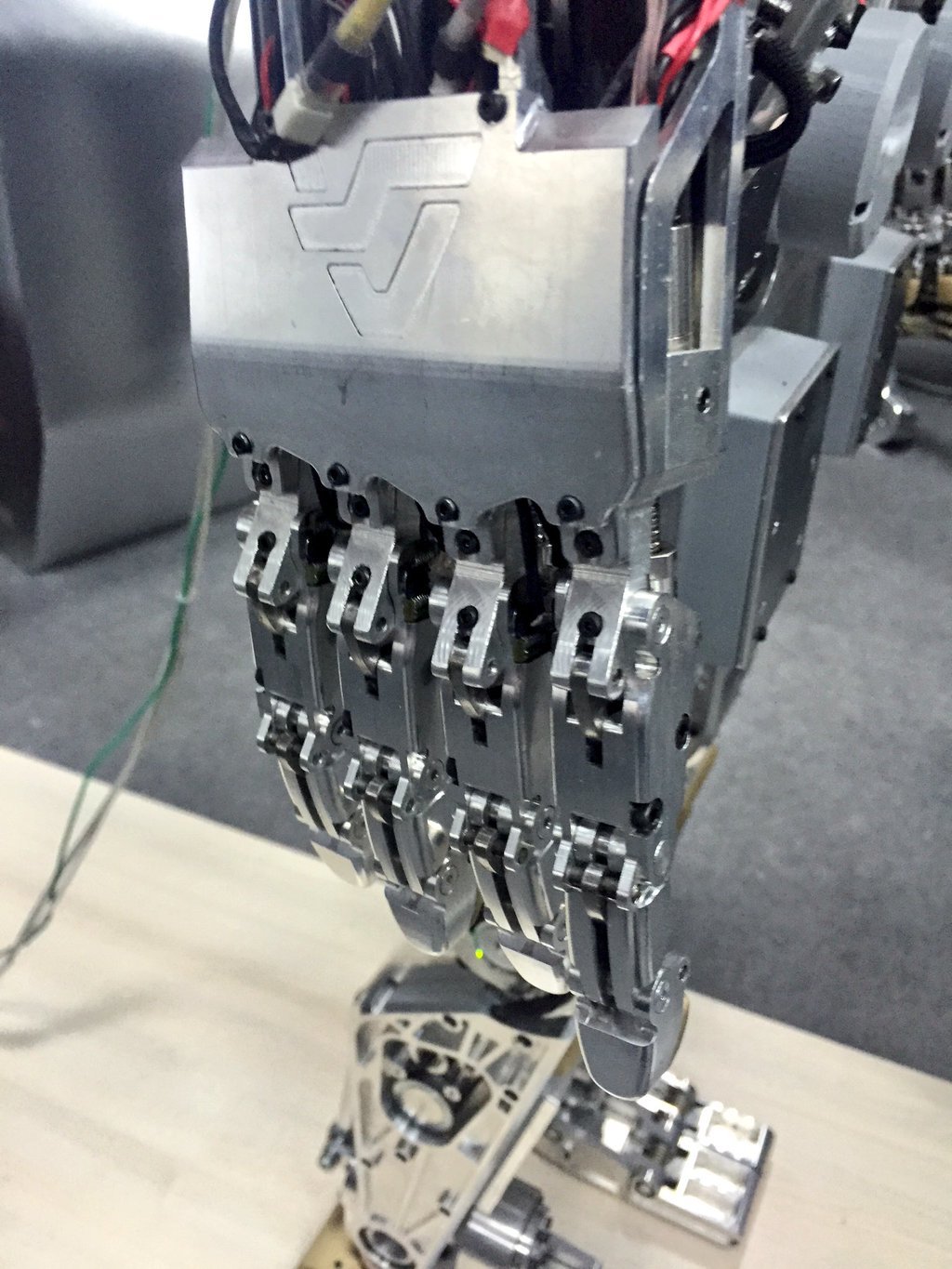
Initially, the creation of an anthropomorphic robot was carried out in the interests of the Emergencies Ministry for rescue work. However, it was subsequently taken into account that most of the components of the rescue robot can also be used for solving military tasks, as well as in astronautics .
“Avatar will be one of the crew members of the future Russian national orbital station,” said Deputy Prime Minister Dmitry Rogozin in February. Such development will allow, without a special spacesuit, to go into outer space and, under the control of an operator-astronaut under protection, carry out particularly complex operations on board the spacecraft.
"Lynx-BP"
“Lynx-BP” is a biomorphic robot, that is, similar to an animal, on four legs. They plan to arm it not only with a machine gun, but also with anti-tank guided missiles, said Vladimir Shashok, director general of the enterprise developing the Lynx enterprise, the Signal Research Institute. According to him, three variants of target load are considered: an intelligence robot, a combat support robot and a robot for carrying goods. “The combat robot will most likely be equipped with a machine gun, and the installation of an ATGM is possible,” he said.
The robot must be able to move on any surfaces and water up to 40 cm in depth, overcome thresholds up to 500 mm, staircases of industrial buildings with an inclination angle of up to 30 ° and a step height of 200 mm, trenches up to 500 mm wide and walls up to 400 mm high and up to 300 mm wide.
On the plain, the robot will reach speeds of up to 15 km / h, over rough terrain - up to 10 km / h.
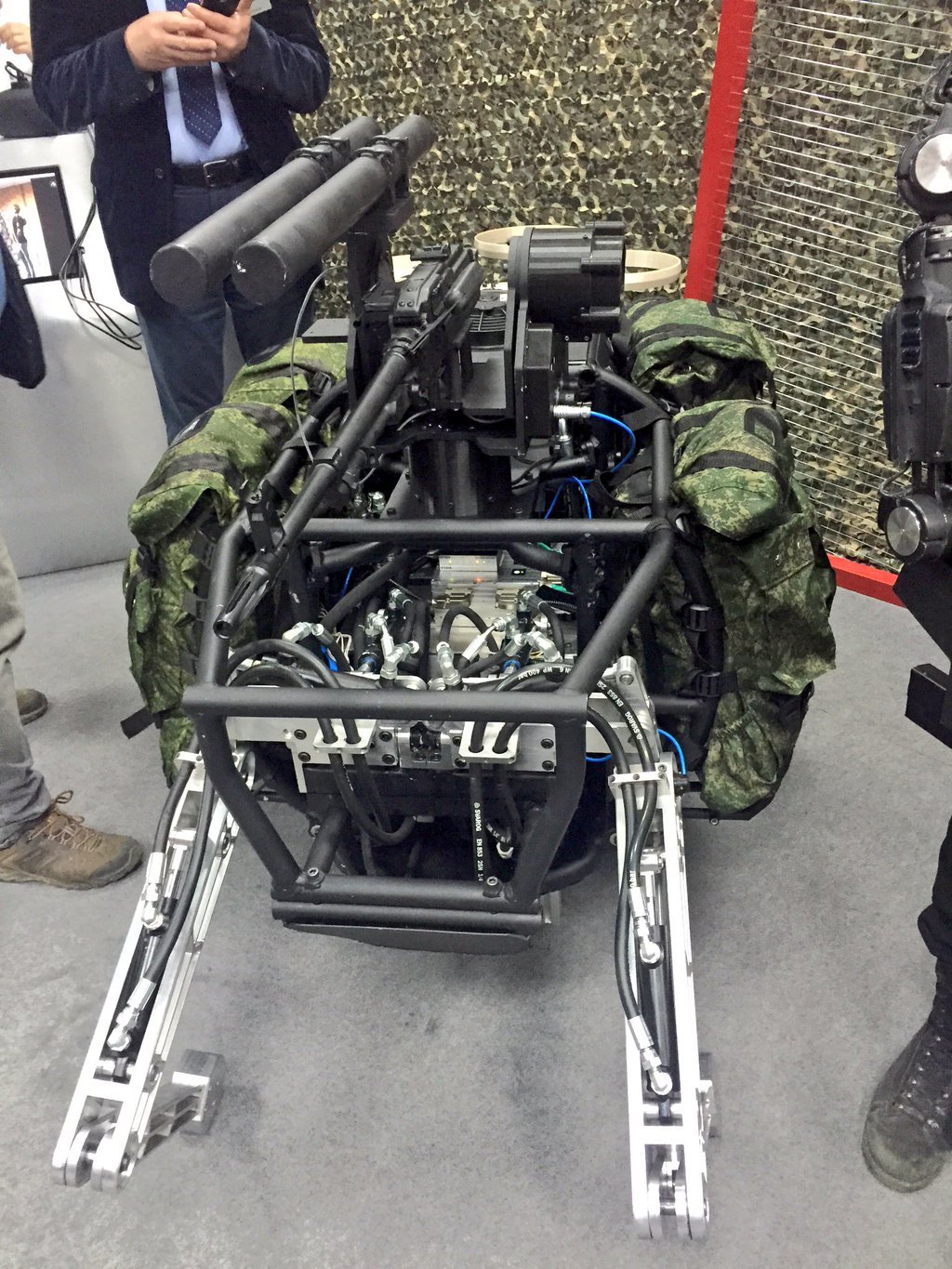
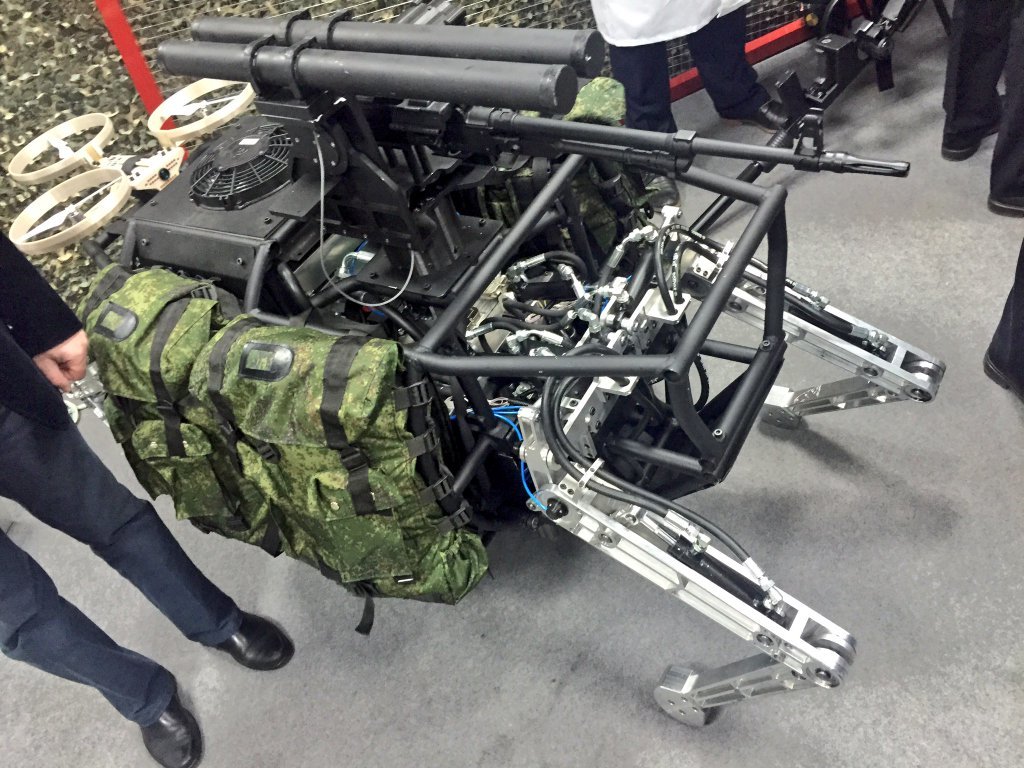
State tests "Lynx-BP" is scheduled to be held in 2019.
The terms of reference for an open competition for the right to conclude a contract for the execution of an integral part of the experimental design work on the subject “Basic platforms for mobile biomorphic robots” contains some technical characteristics of the robot.
Excerpt from the technical specifications
Basic platform of an average mobile biomorphic robot weighing up to 400 kg
Full name - The basic platform of a mobile biomorphic robot weighing up to 400 kg.
The abbreviated name is BPMBR400.
The structure of BPMRB400 should include:
platform;
motion control equipment;
power supply system;
equipment lifting the robot after tipping;
software package.
The platform should include:
housing;
4 lever propulsion;
propulsion drives.
The target load determines the functional purpose.
At BPMBR400 one of the target loads should be set:
- intelligence;
- a platform for transporting ammunition and ammunition;
- means of evacuating the dead and wounded from the battlefield;
- Means of reconnaissance of mine-explosive barriers;
- weapons.
When mounted on a BPMBR400 platform for transporting ammunition and ammunition, the total mass of ammunition and ammunition should be up to 200 kg.
BPMBR400 with installed systems and equipment management and target load, including loaded platform for the transport of ammunition and ammunition, must provide:
- movement in the conditions of urban infrastructure along concrete, asphalt, marble, wooden and soil platforms and platforms with a sandy surface with a depth of up to 100 mm;
- movement over rugged and highly rugged terrain, in icy ice, on fallen leaves, on grass up to 1 m high, snow up to 400 mm deep, in rain, on surfaces covered with water up to 400 mm deep;
- movement in mountainous areas and destroyed urban infrastructure, at industrial enterprises, in industrial and residential premises;
- overcoming:
- thresholds up to 500 mm;
- staircases of industrial buildings and structures with an angle of inclination of up to 30 ° and a step height of up to 200 mm;
- a ditch up to 500 mm wide;
- walls up to 400 mm high and up to 300 mm wide;
- the speed of movement is fully equipped with a payload:
- up to 15 km / h when driving on flat terrain;
- up to 10 km / h when driving on rough terrain.
- steady movement on a horizontal surface with preservation of the initial position of the platform;
- lifting in the equipped state on an inclined surface with an angle of up to 40 °;
- turn on the spot with a change of position no more than 1 m;
- Adaptation of the position of the supporting surfaces of the complex, in accordance with the terrain in automatic mode;
- stable position of the complex when using active systems with a force of no more than 150 N;
- movement on the surface with a bearing capacity of the soil more than 0.2 N / mm² (sandy loams saturated with moisture (plastic));
- preservation of a stable, recoverable position under short-term exposure (t = 0.2 c) on the base platform with a force of up to 150 N;
- lowering the hull of the BPMBR400 to the ground to ensure a stable position and the possibility of subsequent lifting.
The operation of the BPMBR400 should be managed from the on-board information management system and equipment for planning routes and movements in traffic control modes: remote, semi-autonomous, autonomous, and following the beacon (guide).
BPMBR400 should provide translation time:
- from the transport position in the battle - no more than 1 min;
- from the combat position to the transport position - no more than 2 minutes.
The mass of the equipped and filled MBR400 should be no more than 400 kg.
The total mass of ammunition and ammunition transported MBR-400 should be up to 200 kg.
Overall dimensions of the BPMBR400 without target load and antennas should be no more than:
- in a combat position - no more than 2000x1000x1200 mm;
- in the transport position - no more than 2000x1000x600 mm.
The equipment of traffic control should provide the cessation of movement and the transition to the standby mode of the operator’s commands in the following cases:
- collisions with an insurmountable obstacle;
- exceeding the irregularities of the soil surface profile in comparison with the values acceptable for work;
- exceeding the allowable angles of longitudinal and transverse roll BPMBR400.
- unacceptable soil support characteristics.
The operator must be given messages about the reasons for the stop.
Lifting equipment MBR400 after overturning should provide a return to its original position of the MBR400 after tipping "on its side" - turn the MBR400 at an angle of up to 90 °, including with transported ammunition and ammunition.
Power equipment should include:
- Autonomous electrical unit on an internal combustion engine with remote control;
- rechargeable batteries;
- control, switching and protection units;
- fuel tank.
The power supply equipment must provide power to the equipment and equipment with a positive electric power balance under all specified operating conditions, including at an altitude of 3000 m above sea level.
The power supply equipment must provide power to MBR400 consumers from:
- electrical unit in motion and parked - at least 24 hours (with refueling);
- from batteries:
- in motion for at least 0.5 hours;
- at the parking lot - at least 5 hours;
- in standby mode - at least 6 hours.
It should be provided with rechargeable batteries when the generator is operating. The battery should be charged from the charging device (from the remote control).
It should be possible to supply the MBR400 from the remote control network and from the 380/220 industrial network (+10%, - 15%) V with a frequency of 50 1 Hz (GOST 11295-65) through a voltage converter, which should be included in the ZIP-G kit.
-----
The basic platform of a mobile biomorphic robot weighing up to 100 kg.
Full name - The basic platform of a mobile biomorphic robot weighing up to 100 kg.
The abbreviated name is BPMBR100.
The platform should include:
- housing;
- 4 lever propulsion;
- hydraulic drive propulsion.
BPMBR100 should serve as a base for creating a mobile biomorphic robot by installing control systems and instrumentation and target load on it:
- onboard information management system;
- vision equipment;
- data transmission equipment;
- navigation and orientation equipment;
- equipment planning routes and movements:
- traffic control equipment for the lighthouse (guide);
- target load.
At BPMBR100 should be set one of the target loads:
- intelligence;
- a platform for transporting ammunition and ammunition;
- Means of reconnaissance of mine-explosive barriers;
- weapons.
When mounted on a BPMBR100 platform for transporting ammunition and ammunition, the total mass of ammunition and ammunition should be up to 60 kg.
BPMBR100 with installed systems, control equipment and target load, including loaded platform for the transport of ammunition and ammunition, must provide:
- movement in the conditions of urban infrastructure along concrete, asphalt, marble, wooden, soil platforms and platforms with a sandy surface with a depth of up to 100 mm;
- movement over rough terrain on solid soils, in icy lands, on fallen leaves, on grass up to 0.5 m high, snow up to 200 mm deep, in rain, on surfaces covered with water up to 300 mm deep:
- overcoming:
- thresholds up to 400 mm;
- staircases of industrial buildings and structures with an inclination angle of at least 300 and a step height of up to 200 mm;
- a ditch up to 400 mm wide;
- walls up to 300 mm high and up to 200 mm wide;
- the speed of movement is fully equipped with a payload:
- up to 15 km / h when driving on flat terrain;
- up to 10 km / h when driving on rough terrain.
- steady movement on a horizontal surface with preservation of the initial position of the platform;
- lifting in the equipped state on an inclined surface with an angle of up to 40 °;
- turn on the spot with a change of position no more than 1 m;
- Adaptation of the position of the supporting surfaces of the complex, in accordance with the terrain in automatic mode;
- stable position of the complex when using active systems with a force of no more than 150 N;
- movement on the surface with a bearing capacity of the soil more than 0.2 N / mm² (sandy loams saturated with moisture (plastic));
- preservation of a stable, recoverable position under short-term exposure (t = 0.2 c) on the base platform with a force of up to 150 N;
- lowering the hull of the MBR100 to the ground to ensure a stable position and the possibility of subsequent lifting.
The operation of the BPMBR100 should be managed from the on-board information management system and equipment for planning routes and movements in traffic control modes: remote, semi-autonomous, autonomous, and following the beacon (guide).
BPMBR100 should provide translation time:
- from the transport position in the battle - no more than 1 min;
- from the combat position to the transport position - no more than 2 minutes.
The mass of the equipped and filled MBR100 should be no more than 120 kg.
The total mass of ammunition and ammunition transported MBR100 should be up to 60 kg.
Overall dimensions of the BPMBR100 without target load and antennas should be no more than:
- in a combat position - no more than 1500 x 800 x 1000 mm;
- in the transport position - no more than 1500 x 800 x 400 mm.
The equipment of traffic control should provide the cessation of movement and the transition to the standby mode of the operator’s commands in cases of
- collision with irresistible
an obstacle;
- exceeding the irregularities of the soil surface profile in comparison with the values acceptable for work;
- exceeding the allowable angles of longitudinal and transverse roll BPMBR400.
- unacceptable soil support characteristics.
The operator must be given messages about the reasons for the stop.
Lifting equipment MBR100 after tipping should provide a return to its original position MBR100 after tipping “on its side” - turn MBR100 at an angle of up to 90 °, including with transported ammunition and ammunition.
The power supply equipment must provide power to the equipment and equipment with a positive electric power balance under all specified operating conditions, including at an altitude of 3000 m above sea level.
The power supply equipment should provide power supply for MBR100 consumers from:
- electrical unit in motion and parked - at least 24 hours (with refueling);
- from batteries:
- in motion for at least 0.5 hours;
- at the parking lot - at least 5 hours;
- in standby mode - at least 6 hours.
Power supply equipment must provide:
- powering the starter circuit of the electrical unit from the batteries of the power supply equipment;
- manual and remote start and stop of the electrical unit;
- manual, automatic and remote connection of the electrical unit to the onboard network of ICBMs;
- automatic disconnection of consumers from the electrical unit during its launch;
- connection and disconnection of the batteries to the onboard ICBM;
- power supply to consumers of MBRs from an external DC source with an output voltage of 27.5 ± 1.0 V, provided that the batteries are connected to the main network of ICBMs;
- formation of output voltages for the power supply of consumers with quality that meets the requirements of GOST RV 20.39.309-98;
- protection of power supply circuits of consumers against overloads, short circuits and polarity reversal;
- disconnection of batteries from the power supply network when the battery voltage is less than 22.5-0.5 V
It should be provided with rechargeable batteries when the generator is operating. The battery should be charged from the charging device (from the remote control).
The possibility of power supply of MBR100 from the remote control network and from the industrial network with voltage of 380/220 (+10%, - 15%) V with a frequency of 50 1 Hz (GOST 11295-65) should be provided through the voltage converter, which should be included in the ZIP-G kit.
------
Electronic equipment for EMC, noise immunity and electronic masking must comply with the requirements of GOST RV 20.39.309-98.
The means of data transmission of elements of a 400 (100) should ensure their electromagnetic compatibility and function normally under conditions of intentional and unintentional interference.
BPMBR400 (BPMBR100) must be resistant to the effects of natural and man-made EMF in accordance with GOST RV 20.39.308-98.
For durability, strength and resistance to external influencing factors, BPMBR400 (BPMBR100) must meet the requirements of GOST RV 20.39.304-98 group 1.4.1 of the O version (taking into account clause 4.16 for BPMBR 100) with the following clarifications:
- low ambient temperature:
- working - minus 40 ° ;
- limit - minus 40 ° ;
- high ambient temperature:
- working - plus 50 ° ;
- limit - plus 50 ° ;
- change in ambient temperature from minus 40 ° to + 50 ° C.
There are no requirements for resistance to components of rocket fuel and aggressive media and mold fungi.
The average operating time of BPMBR400 (BPMBR100) between failures must be at least 1500 hours.
Notes:
1. The failure criterion is the impossibility of further use of the BPMBR400 (BPMBR100) for its intended purpose without repair.
The average time for restoring the operational state of a BPMBR400 (BPMBR100) using the ZIP-O composition and a group ZIP kit (ZIP-G) should be no more than 2.5 hours without taking into account the delivery time of the replaced component.
The average life of BPMBR400 (BPMBR100) must be at least 1000 hours.
The average lifetime of BPMBR400 (BPMBR100) is at least 5 years.
The average shelf life of BPMBR400 (BPMBR100) must be at least 10 years.
The continuous operation time of BPMBR400 (BPMBR100) must be at least 24 hours.
The storage life of a BPMBR400 (BPMBR100) under conditions of unheated storages (temperature from minus 35 ° to + 45 ° C. at a relative humidity of up to 85%) should be 10 years, including one year in field conditions in a regular container.
The design of the BPMBR400 (BPMBR100) should provide for the applicability of standard and borrowed parts and assemblies.
The nomenclature of used brands and the range of materials should be minimal.
Applied oils, lubricants, fluids should be from the nomenclature of accepted for supply troops.
BPMBR400 (BPMBR100) should be built on a modular basis, providing replacement of tools, components and assemblies in the event of their failure, have the necessary unification of the composition of technical means, capabilities of general, system-wide software, information and linguistic
The paints and electroplated coatings used in the construction of BPMBR400 (BPMBR100) should not sustain combustion when exposed to the flame and ensure the corrosion resistance of the instruments during storage and operation as part of BPMBR400 (BPMBR100).
The design of a BPMBR400 (BPMBR100) should exclude the possibility of improper connection of the harness connectors.
The design of the BPMBR400 (BPMBR100) should provide for the possibility of installing armor protection.
In the development of BPMBR400 (BPMBR100) raw materials, materials and electrical products of domestic production should be used.
Components of electrical equipment should be applied in accordance with the lists allowing their use in military products.
The use of import components is made in the prescribed manner.
Stage 1. Development of draft technical project. Development, production and testing of a BPMBR400 model for confirming decisions made at the stage of a draft technical project and determining the attainability of TK requirements.
Deadline - August 2015 - November 2016
Stage 2. Development of working design documentation for manufacturing prototypes of mobile biomorph robots platforms.
Deadline - December 2016 - July 2017.
Stage 3. Manufacturing prototypes of mobile biomorphic robots platforms and conducting preliminary tests.
Deadline - August 2017 - December 2018
Stage 4. Participation in the State tests of a prototype.
Deadline - January 2019 - June 2019
*****
After many desirable characteristics, the documentation states “Conditions and characteristics ... are specified at the stage of development of a draft technical project”.
Full name - The basic platform of a mobile biomorphic robot weighing up to 400 kg.
The abbreviated name is BPMBR400.
The structure of BPMRB400 should include:
platform;
motion control equipment;
power supply system;
equipment lifting the robot after tipping;
software package.
The platform should include:
housing;
4 lever propulsion;
propulsion drives.
The target load determines the functional purpose.
At BPMBR400 one of the target loads should be set:
- intelligence;
- a platform for transporting ammunition and ammunition;
- means of evacuating the dead and wounded from the battlefield;
- Means of reconnaissance of mine-explosive barriers;
- weapons.
When mounted on a BPMBR400 platform for transporting ammunition and ammunition, the total mass of ammunition and ammunition should be up to 200 kg.
BPMBR400 with installed systems and equipment management and target load, including loaded platform for the transport of ammunition and ammunition, must provide:
- movement in the conditions of urban infrastructure along concrete, asphalt, marble, wooden and soil platforms and platforms with a sandy surface with a depth of up to 100 mm;
- movement over rugged and highly rugged terrain, in icy ice, on fallen leaves, on grass up to 1 m high, snow up to 400 mm deep, in rain, on surfaces covered with water up to 400 mm deep;
- movement in mountainous areas and destroyed urban infrastructure, at industrial enterprises, in industrial and residential premises;
- overcoming:
- thresholds up to 500 mm;
- staircases of industrial buildings and structures with an angle of inclination of up to 30 ° and a step height of up to 200 mm;
- a ditch up to 500 mm wide;
- walls up to 400 mm high and up to 300 mm wide;
- the speed of movement is fully equipped with a payload:
- up to 15 km / h when driving on flat terrain;
- up to 10 km / h when driving on rough terrain.
- steady movement on a horizontal surface with preservation of the initial position of the platform;
- lifting in the equipped state on an inclined surface with an angle of up to 40 °;
- turn on the spot with a change of position no more than 1 m;
- Adaptation of the position of the supporting surfaces of the complex, in accordance with the terrain in automatic mode;
- stable position of the complex when using active systems with a force of no more than 150 N;
- movement on the surface with a bearing capacity of the soil more than 0.2 N / mm² (sandy loams saturated with moisture (plastic));
- preservation of a stable, recoverable position under short-term exposure (t = 0.2 c) on the base platform with a force of up to 150 N;
- lowering the hull of the BPMBR400 to the ground to ensure a stable position and the possibility of subsequent lifting.
The operation of the BPMBR400 should be managed from the on-board information management system and equipment for planning routes and movements in traffic control modes: remote, semi-autonomous, autonomous, and following the beacon (guide).
BPMBR400 should provide translation time:
- from the transport position in the battle - no more than 1 min;
- from the combat position to the transport position - no more than 2 minutes.
The mass of the equipped and filled MBR400 should be no more than 400 kg.
The total mass of ammunition and ammunition transported MBR-400 should be up to 200 kg.
Overall dimensions of the BPMBR400 without target load and antennas should be no more than:
- in a combat position - no more than 2000x1000x1200 mm;
- in the transport position - no more than 2000x1000x600 mm.
The equipment of traffic control should provide the cessation of movement and the transition to the standby mode of the operator’s commands in the following cases:
- collisions with an insurmountable obstacle;
- exceeding the irregularities of the soil surface profile in comparison with the values acceptable for work;
- exceeding the allowable angles of longitudinal and transverse roll BPMBR400.
- unacceptable soil support characteristics.
The operator must be given messages about the reasons for the stop.
Lifting equipment MBR400 after overturning should provide a return to its original position of the MBR400 after tipping "on its side" - turn the MBR400 at an angle of up to 90 °, including with transported ammunition and ammunition.
Power equipment should include:
- Autonomous electrical unit on an internal combustion engine with remote control;
- rechargeable batteries;
- control, switching and protection units;
- fuel tank.
The power supply equipment must provide power to the equipment and equipment with a positive electric power balance under all specified operating conditions, including at an altitude of 3000 m above sea level.
The power supply equipment must provide power to MBR400 consumers from:
- electrical unit in motion and parked - at least 24 hours (with refueling);
- from batteries:
- in motion for at least 0.5 hours;
- at the parking lot - at least 5 hours;
- in standby mode - at least 6 hours.
It should be provided with rechargeable batteries when the generator is operating. The battery should be charged from the charging device (from the remote control).
It should be possible to supply the MBR400 from the remote control network and from the 380/220 industrial network (+10%, - 15%) V with a frequency of 50 1 Hz (GOST 11295-65) through a voltage converter, which should be included in the ZIP-G kit.
-----
The basic platform of a mobile biomorphic robot weighing up to 100 kg.
Full name - The basic platform of a mobile biomorphic robot weighing up to 100 kg.
The abbreviated name is BPMBR100.
The platform should include:
- housing;
- 4 lever propulsion;
- hydraulic drive propulsion.
BPMBR100 should serve as a base for creating a mobile biomorphic robot by installing control systems and instrumentation and target load on it:
- onboard information management system;
- vision equipment;
- data transmission equipment;
- navigation and orientation equipment;
- equipment planning routes and movements:
- traffic control equipment for the lighthouse (guide);
- target load.
At BPMBR100 should be set one of the target loads:
- intelligence;
- a platform for transporting ammunition and ammunition;
- Means of reconnaissance of mine-explosive barriers;
- weapons.
When mounted on a BPMBR100 platform for transporting ammunition and ammunition, the total mass of ammunition and ammunition should be up to 60 kg.
BPMBR100 with installed systems, control equipment and target load, including loaded platform for the transport of ammunition and ammunition, must provide:
- movement in the conditions of urban infrastructure along concrete, asphalt, marble, wooden, soil platforms and platforms with a sandy surface with a depth of up to 100 mm;
- movement over rough terrain on solid soils, in icy lands, on fallen leaves, on grass up to 0.5 m high, snow up to 200 mm deep, in rain, on surfaces covered with water up to 300 mm deep:
- overcoming:
- thresholds up to 400 mm;
- staircases of industrial buildings and structures with an inclination angle of at least 300 and a step height of up to 200 mm;
- a ditch up to 400 mm wide;
- walls up to 300 mm high and up to 200 mm wide;
- the speed of movement is fully equipped with a payload:
- up to 15 km / h when driving on flat terrain;
- up to 10 km / h when driving on rough terrain.
- steady movement on a horizontal surface with preservation of the initial position of the platform;
- lifting in the equipped state on an inclined surface with an angle of up to 40 °;
- turn on the spot with a change of position no more than 1 m;
- Adaptation of the position of the supporting surfaces of the complex, in accordance with the terrain in automatic mode;
- stable position of the complex when using active systems with a force of no more than 150 N;
- movement on the surface with a bearing capacity of the soil more than 0.2 N / mm² (sandy loams saturated with moisture (plastic));
- preservation of a stable, recoverable position under short-term exposure (t = 0.2 c) on the base platform with a force of up to 150 N;
- lowering the hull of the MBR100 to the ground to ensure a stable position and the possibility of subsequent lifting.
The operation of the BPMBR100 should be managed from the on-board information management system and equipment for planning routes and movements in traffic control modes: remote, semi-autonomous, autonomous, and following the beacon (guide).
BPMBR100 should provide translation time:
- from the transport position in the battle - no more than 1 min;
- from the combat position to the transport position - no more than 2 minutes.
The mass of the equipped and filled MBR100 should be no more than 120 kg.
The total mass of ammunition and ammunition transported MBR100 should be up to 60 kg.
Overall dimensions of the BPMBR100 without target load and antennas should be no more than:
- in a combat position - no more than 1500 x 800 x 1000 mm;
- in the transport position - no more than 1500 x 800 x 400 mm.
The equipment of traffic control should provide the cessation of movement and the transition to the standby mode of the operator’s commands in cases of
- collision with irresistible
an obstacle;
- exceeding the irregularities of the soil surface profile in comparison with the values acceptable for work;
- exceeding the allowable angles of longitudinal and transverse roll BPMBR400.
- unacceptable soil support characteristics.
The operator must be given messages about the reasons for the stop.
Lifting equipment MBR100 after tipping should provide a return to its original position MBR100 after tipping “on its side” - turn MBR100 at an angle of up to 90 °, including with transported ammunition and ammunition.
The power supply equipment must provide power to the equipment and equipment with a positive electric power balance under all specified operating conditions, including at an altitude of 3000 m above sea level.
The power supply equipment should provide power supply for MBR100 consumers from:
- electrical unit in motion and parked - at least 24 hours (with refueling);
- from batteries:
- in motion for at least 0.5 hours;
- at the parking lot - at least 5 hours;
- in standby mode - at least 6 hours.
Power supply equipment must provide:
- powering the starter circuit of the electrical unit from the batteries of the power supply equipment;
- manual and remote start and stop of the electrical unit;
- manual, automatic and remote connection of the electrical unit to the onboard network of ICBMs;
- automatic disconnection of consumers from the electrical unit during its launch;
- connection and disconnection of the batteries to the onboard ICBM;
- power supply to consumers of MBRs from an external DC source with an output voltage of 27.5 ± 1.0 V, provided that the batteries are connected to the main network of ICBMs;
- formation of output voltages for the power supply of consumers with quality that meets the requirements of GOST RV 20.39.309-98;
- protection of power supply circuits of consumers against overloads, short circuits and polarity reversal;
- disconnection of batteries from the power supply network when the battery voltage is less than 22.5-0.5 V
It should be provided with rechargeable batteries when the generator is operating. The battery should be charged from the charging device (from the remote control).
The possibility of power supply of MBR100 from the remote control network and from the industrial network with voltage of 380/220 (+10%, - 15%) V with a frequency of 50 1 Hz (GOST 11295-65) should be provided through the voltage converter, which should be included in the ZIP-G kit.
------
Electronic equipment for EMC, noise immunity and electronic masking must comply with the requirements of GOST RV 20.39.309-98.
The means of data transmission of elements of a 400 (100) should ensure their electromagnetic compatibility and function normally under conditions of intentional and unintentional interference.
BPMBR400 (BPMBR100) must be resistant to the effects of natural and man-made EMF in accordance with GOST RV 20.39.308-98.
For durability, strength and resistance to external influencing factors, BPMBR400 (BPMBR100) must meet the requirements of GOST RV 20.39.304-98 group 1.4.1 of the O version (taking into account clause 4.16 for BPMBR 100) with the following clarifications:
- low ambient temperature:
- working - minus 40 ° ;
- limit - minus 40 ° ;
- high ambient temperature:
- working - plus 50 ° ;
- limit - plus 50 ° ;
- change in ambient temperature from minus 40 ° to + 50 ° C.
There are no requirements for resistance to components of rocket fuel and aggressive media and mold fungi.
The average operating time of BPMBR400 (BPMBR100) between failures must be at least 1500 hours.
Notes:
1. The failure criterion is the impossibility of further use of the BPMBR400 (BPMBR100) for its intended purpose without repair.
The average time for restoring the operational state of a BPMBR400 (BPMBR100) using the ZIP-O composition and a group ZIP kit (ZIP-G) should be no more than 2.5 hours without taking into account the delivery time of the replaced component.
The average life of BPMBR400 (BPMBR100) must be at least 1000 hours.
The average lifetime of BPMBR400 (BPMBR100) is at least 5 years.
The average shelf life of BPMBR400 (BPMBR100) must be at least 10 years.
The continuous operation time of BPMBR400 (BPMBR100) must be at least 24 hours.
The storage life of a BPMBR400 (BPMBR100) under conditions of unheated storages (temperature from minus 35 ° to + 45 ° C. at a relative humidity of up to 85%) should be 10 years, including one year in field conditions in a regular container.
The design of the BPMBR400 (BPMBR100) should provide for the applicability of standard and borrowed parts and assemblies.
The nomenclature of used brands and the range of materials should be minimal.
Applied oils, lubricants, fluids should be from the nomenclature of accepted for supply troops.
BPMBR400 (BPMBR100) should be built on a modular basis, providing replacement of tools, components and assemblies in the event of their failure, have the necessary unification of the composition of technical means, capabilities of general, system-wide software, information and linguistic
The paints and electroplated coatings used in the construction of BPMBR400 (BPMBR100) should not sustain combustion when exposed to the flame and ensure the corrosion resistance of the instruments during storage and operation as part of BPMBR400 (BPMBR100).
The design of a BPMBR400 (BPMBR100) should exclude the possibility of improper connection of the harness connectors.
The design of the BPMBR400 (BPMBR100) should provide for the possibility of installing armor protection.
In the development of BPMBR400 (BPMBR100) raw materials, materials and electrical products of domestic production should be used.
Components of electrical equipment should be applied in accordance with the lists allowing their use in military products.
The use of import components is made in the prescribed manner.
Stage 1. Development of draft technical project. Development, production and testing of a BPMBR400 model for confirming decisions made at the stage of a draft technical project and determining the attainability of TK requirements.
Deadline - August 2015 - November 2016
Stage 2. Development of working design documentation for manufacturing prototypes of mobile biomorph robots platforms.
Deadline - December 2016 - July 2017.
Stage 3. Manufacturing prototypes of mobile biomorphic robots platforms and conducting preliminary tests.
Deadline - August 2017 - December 2018
Stage 4. Participation in the State tests of a prototype.
Deadline - January 2019 - June 2019
*****
After many desirable characteristics, the documentation states “Conditions and characteristics ... are specified at the stage of development of a draft technical project”.
Exoskeleton
On the military exoskeleton details have not been disclosed. Judging by the photos, with his help, the fighter will fix the arm with the weapon in a bent state. The load from the shoulder is transferred to the back.
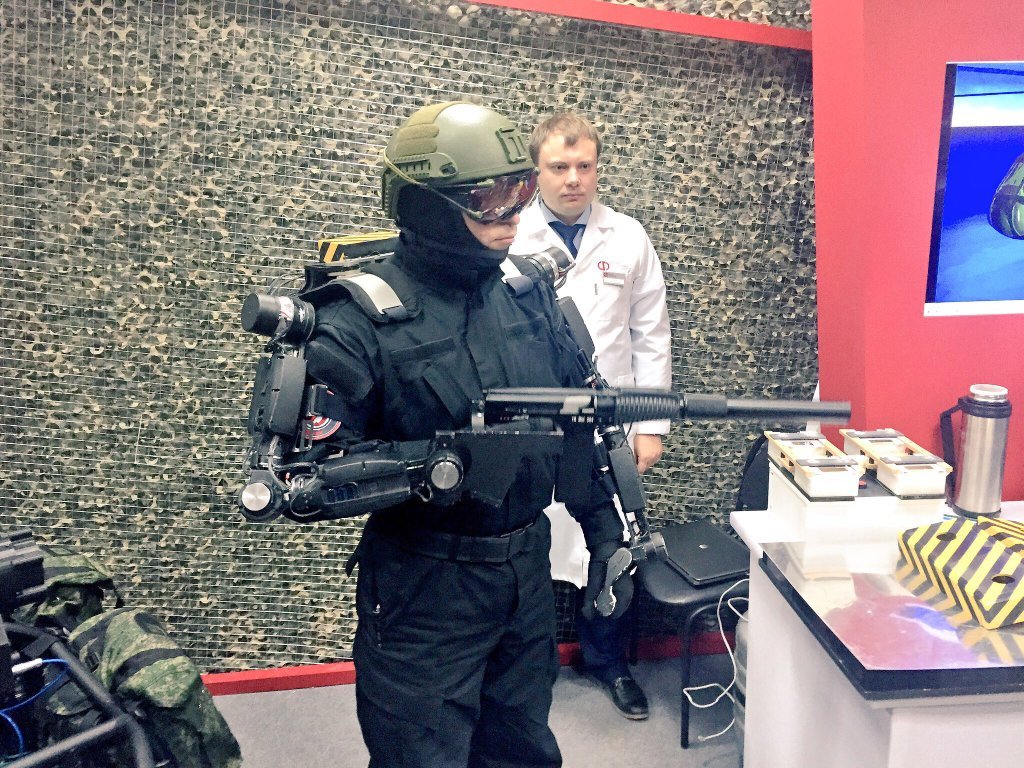
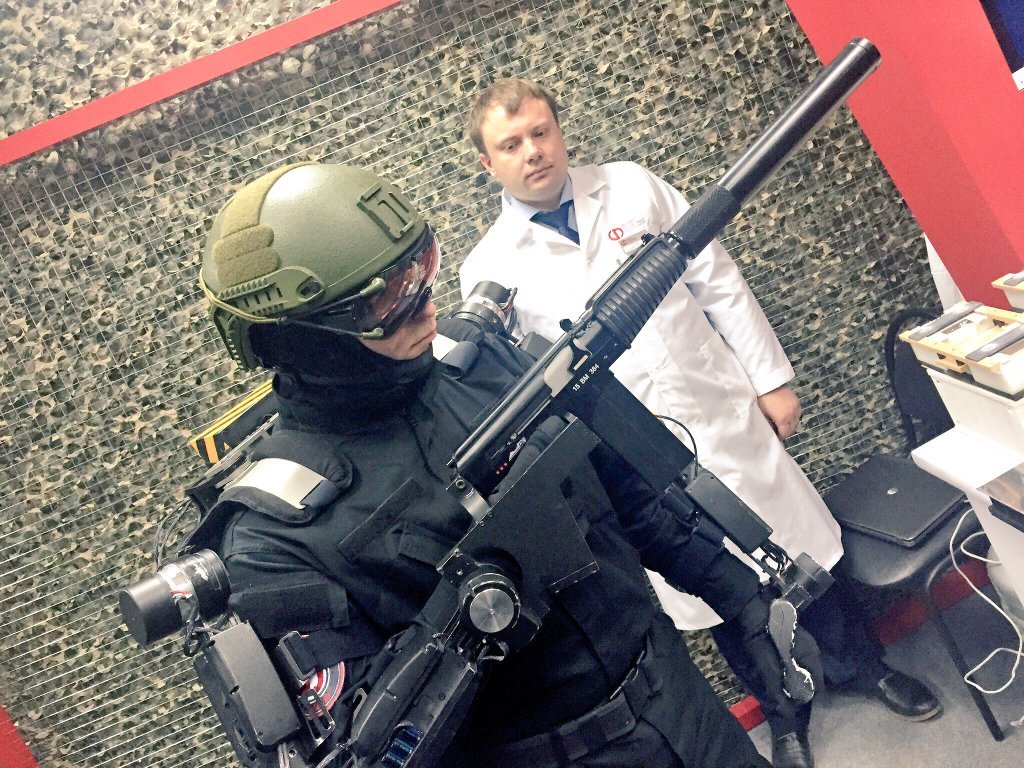
The presented robots will find application in the Ministry of Emergency Situations, astronautics, in the Russian army and abroad: a significant amount of Rostec weapons is supplied for export.
In addition to robots, TsNIITOCHMASH also showed a lot of interesting things. For example, a test girl, a blonde, showed off a new protective suit for the army, walking through a minefield through flames and explosions. Pyrotechnics exploded spectacularly under her feet.
Vice Prime Minister Rogozin compared the girl with the Terminator.
Source: https://habr.com/ru/post/393325/
All Articles